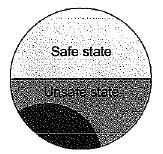Test: Deadlock- 2 - Computer Science Engineering (CSE) MCQ
9 Questions MCQ Test - Test: Deadlock- 2
| 1 Crore+ students have signed up on EduRev. Have you? Download the App |
Suppose we have a system in which processes is in hold and wait condition then which of the following approach prevent the deadlock.
An operating system makes use of Banker’s algorithm to allocate 12 printers. Printers will be allocated to a process requesting them only if there are enough available printers to allow it to run to completion.
User 1 using 7 printers and will need at most a total of 10 printers.
User 2 is using 1 printer and will need at most 4 printers.
User 3 is using 2 printers and will need at most 4 printers.
Each user is currently requesting 1 more printer, Which of the following is true?
A state is safe if the system can allocate resources to each process (up to its maximum) in some order and still avoid deadlock, which of the following is/are true
1. Deadlocked state is unsafe,
2. Unsafe state may lead to a deadlock situation.
3. Unsafe state must lead to a deadlock situation.
4. Deadlock state is a subset of unsafe state,
Which of the following is NOT true of deadlock prevention and deadlock avoidance schemes?
An operating system implements a policy that requires a process to release all resources before making a request for another resource.



















